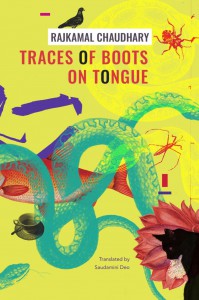In this month’s round-up, we present three works in singular styles. From Venezuela, Maria Pérez-Talavera gives us non-linear journal entries composed from a mental hospital. From Poland, modernist master Witold Gombrowicz puts his own spin on the Gothic tale, painting a psychologically sensitive portrait of a shifting society. And from India, some of the bold, experimental short stories of Rajkamal Chaudhary are gathered in a sharp and comic collection of unconventional plotlines and characters. Read on to find out more!

The Possessed by Witold Gombrowicz, translated from the Polish by Antonia Lloyd-Jones, Fitzcarraldo, 2023
Review by Iona Tait, Executive Assistant
A haunted castle, a mad prince, a pair of doubles, and a clairvoyant who saves the day—Witold Gombrowicz’s The Possessed has all the quintessential trappings of nineteenth-century Gothic fiction. Originally released as a serial in the summer of 1939, The Possessed merges its classic motifs with mystery and a comedy of manners, offering a remarkably profound reflection on authenticity at a time when older Polish divisions of social classes were being transformed.
Neighboring the Gothic castle—that relic of “antiquity breathing its last” where a deranged prince and his cunning secretary reside—lies a manor-turned-boarding house. Mrs. Ocholowska, the landowner and member of a downwardly mobile minor nobility, receives guests across all social classes: the petit-bourgeois Councilor Szymczyk, nosy and bickering middle-class women, a curious academic known as Skolinski, and a working-class tennis coach and parvenu named Marian Leszczuk. The latter proves to be a formidable rival to the tennis superstar and spritely daughter of the landowner, Maja Ocholowska, who is at the novel’s outset engaged to the secretary.
Lesczuk and Maja, however, are not only an equal match on the court; they also exhibit an uncanny similarity in their gestures and ways of speaking. Simultaneously attracted to and repulsed by this similarity, the pair undergo a process of self-discovery together, journeying between the manor and the haunted castle, with intermittent getaways to Warsaw.
Throughout, the mysteries surrounding the haunted castle continue to unravel at a thrilling pace. But while the prince’s insanity and a shock murder in Warsaw drive much of the plot, the novel also presents a clash between a wild, modern youth and the ossified social divisions upheld by an older generation. From the opening scene, Gombrowicz confronts us with the conflict between these two worlds: on the train to the manor house, the councilor—a “stickler for form with the face of a fish”—becomes enraged when confronted by the young Leszczuk’s “free and frivolous tone.” Belonging to the old world of Poland where class and status triumph over all, the councilor is curious about the social standing of the young man—whom he deems neither proletarian nor bourgeois but rather “a sort of hybrid.”
Despite this seeming dissolution of traditional values, however, questions of status still trouble the younger characters; Leszczuk is keen to escape his humble origins by becoming a great tennis player, while Maja is ashamed of her feelings towards the tennis coach as she continues to entertain her relationship with the secretary, which is predicated on his proximity to wealth. Nonetheless, the very fact that Maja and Lesczuk display a likeness defies the norms of civil society. To the horror of Mrs. Ocholowska and the onlooking busybodies, Maja and Leszczuk’s first tennis match represents the “leveling [of] all classes and castes.” The two are thus harbingers of a type of modernity, slowly encroaching upon Poland.
Gombrowicz is, however, no moralist. Maja and Leszczuk may be “joined by the same fervor, the same vitality, the same passion for life” that is absent in the older generation, but they also have a destructive potential. The young pair often act in moments of frenzy, most viscerally shown in a violent and disturbing episode where Maja encourages Leszczuk to kill a squirrel. Their passion is exciting, liberating, dangerous—and it is in this context that Gombrowicz’s use of Gothic motifs takes on a larger meaning; the presence of dark forces underlying the youthful liveliness permits an exploration of what lurks beneath our social roles. Throughout his oeuvre (most notably in his first novel, Ferdyduke), Gombrowicz has long looked at how the passage from immaturity to maturity entails an adoption of social masks, something he termed as form. By making use of the fantastical and the uncanny in The Possessed, Gombrowicz interrogates the darker and more profound structures of life kept in check by the artificiality of this form. Whilst one could arguably read Maja and Lesczuk’s abnormal—and sometimes monstrous—behavior as more authentic than the older generation’s deference to social status and position, Gombrowicz instead seems to be examining how every individual is constantly reinventing themselves in relation to others. The young pair’s journey of self-discovery is one of entanglement and dependence. They are not any more or less immune to external influence than the preceding generations, but continue to display a susceptibility to be possessed by “unknown” spiritual forces which “depend upon . . . psychological make-up.” In this, the author proffers a discomfiting view of freedom, which implies that social roles hide certain stark and distressing truths about human nature: the brutal bestiality under our masks. Exploring the competing ways in which we compare and assimilate ourselves in our search for a self, Gombrowicz suggests that the individual only exists as a matter of relations, and Maja and Leszczuk are no exception.
Antonia Lloyd-Jones, the award-winning translator of Olga Tokarczuk, has rendered this distinctive tale into an English that conveys Gombrowicz’s eerie yet humorous tone. At times, however, it has to be said that the Gothic elements do not stray far from cliché; many of the descriptions of the outdoors are prosaic, and the arrival of the clairvoyant all too neatly ties up any loose threads. Gombrowicz himself was always vocal about his intentions: he wanted to assess whether writing a “bad novel” was as demanding as “writing a good one,” as he wrote in his Polish Memories. But despite this dismissive, The Possessed cannot only be viewed in light of this statement; whilst the author had hoped to appeal to a wider readership through a popular genre, part of his originality lies in his ability to merge styles, seamlessly mixing the high and the low, the grotesque and the mundane. With this distinctly innovative quality, Gombrowicz’s innate philosophical ambivalence carries this novel into exciting territory, reaping a psychologically rich material from what could have been, in the hands of a lesser writer, a mere pastiche.

Traces of Boots on Tongue by Rajkamal Chaudhary, translated from the Hindi by Saudamini Deo, Seagull Books, 2023
Review by Daljinder Johal, Assistant Managing Editor
Traces of Boots on Tongue is a selection of Hindi-language short stories by Rajkamal Chaudhary, a writer and poet in both Hindi and Maithili. In these narratives, one finds an approach similar to that of folktale; Chaudhary tells the stories of everyday Indians post-independence, granting them a timelessness while masterfully depicting their humanity, and thus avoiding any pitfall of conforming characters to narrow definitions.
In some of the stories, the influence of folktale applies to both the characters and the plot. In “Veni Sanhar,” we are introduced to Sita, who feels like a “medieval princess” and “lives in a high school quarter near the forest.” She marries Triloknath and encounters the worries of ordinary life as a new mother and stepmother; he worries about her health, and she ignores it. But the story turns unusual as depictions of her struggles with madness are introduced. In one instance, she is haunted by a frightening black cat with “mottled patches on a black body, as horrific as a bull-dog. and hideous face, eyes are red, and burning.” This leads to chaos, with Sita even choking Triloknath, and concludes mysteriously and memorably with the cat and woman alone, running in the forest.
Other stories, such as “Like a Wall of Glass,” evoke the learnings of traditional parables through the plot. In this narrative, the protagonist Kapoor visits Dr Jaiswal and his wife Mrs. Satya Jaiswal. Gifting the former a puppet he’s made and named “Glass Fairy,” he is then taken with the latter as he projects his melancholy of parting with the Glass Fairy onto this new object of interest. Kapoor often reduces others by using them in his work; often, even in the company of others, he obsesses about his own perspective on life and art, and this continues as he presents Mrs. Satya Jaiswal with a portrait he’s made in her likeness. Though initially delighted, she ultimately gives the portrait away to a minister who expresses admiration for it, and Kapoor is left speechless. With this, Chaudhary brings humour to the parable, with Kapoor perhaps learning to focus less on treating his works as gifts—when they are really more about his own desires.
Veering across the traditional and the novel, the strength of the collection lies in the variety of its tales. References to queens and snakes, Radha and Sita, abound and contribute to the lyrical and imaginative quality of the prose, but the real power is in the challenging, three-dimensional characters that Chaudhary brings to life; this particularly extends to the collection’s female characters, who are fortified with an important potency in their sexuality.
In “Elementary Knowledge of Geography,” a sensuality is asserted by Manmohini Devi, the mother of the protagonist’s friend. In an especially tense passage, the protagonist describes how “she pulled me near her, placed my head and half of my upper body on her lap and began to caress me.” This attempt at seduction proves to be unsuccessful, but it invites further insight into this more complex woman via the young man’s parents. His father praises Manmohini Devi, saying: “Rama’s mother has suffered a lot . . . if it were any other woman, she would have hung herself or turned to prostitution . . . It was Rama’s mother who somehow ran the household.” In contrast, his mother describes her as “a modern woman,” who “eats tobacco despite being a widow . . .”
The protagonist himself is largely more preoccupied by his own desires to cast any true judgement on Manmohini Devi, but in comparing her with a snake, Chaudhary implies a lithe, predatory nature, and shrouds the woman in mystique through the protagonist’s perspective. This, at times, may feel like a frustrating part of many of Chaudhary’s stories as despite featuring many multi-layered female characters, the main perspective is often a male voice, and we are selectively given access to alternative viewpoints.
For example, in “Pyramid,” the story is mostly told from the perspective of a man, Rasiklal, who brings a young woman, Kummi, to the home he shares with his wife Jaimala and the servant, Muniyan—both of whom are present. Rasiklal, to no surprise, delights in this situation. While touching Kummi’s wrist, shoulder, and back, he repeatedly inflates himself with comments on the house, the well-decorated drawing room, and the wife making tea for him in the kitchen. Though we hear little of Kummi’s perspective at first, snippets of insight clarifies the dynamic: “Kummi started smiling repeatedly, but she felt angry inside. She wanted to return to her own home by 9 PM tonight by any means.”
But the story does not proceed like a typical seduction. When Rasiklal approaches her for a kiss, “he change[s] his mind in the middle of moving his face towards Kummi’s lips.” After this, she softens, laughing during the remainder of her stay and thinking: “No one gets upset if she returns late at night.” We continue to gain insight into the real personality behind a seemingly shy and obedient woman, as Kummi and the other women of the story slowly gain the upper hand against Rasiklal. During Kummi’s eventual departure, she laughingly tells Rasiklal about his rudeness, upon which he can only smile and banter back about this situation of his own making. By the end of the story, he has decided that he is “imprisoned inside this triangular pyramid” of women in the story—the “playing card wives” of “Kummi the queen of hearts, Muniyan the queen of pikes, and the queen of tiles Jaimala, the mistress of this house.”
There is a sense that the reader is meant to laugh at rather than sympathize with Rasiklal after his dramatics, lying on the sofa like a mummy and surrounded by women who are too busy to be concerned with him. In such nuanced use of humour, Chaudhary uses the short story as a vehicle for lighter commentary on the theatre of the everyday—a bit of the fairytale sprinkled into the ordinary.

Figures of Wood by María Pérez-Talavera, translated from the Spanish by Paul Filev, What Books Press, 2023
Review by George Newton, Assistant Editor (Fiction)
Pérez-Talavera’s novella, recently translated from Spanish into English by Paul Filev as Figures of Wood, takes the form of a first-person journal written by a patient in a psychiatric hospital, whose name is only ever referred to as the mysterious L. The narrator uses his present in the psychiatric facility as a starting point, before expanding the narrative into descriptions of his experiences as a patient, the circumstances of his childhood, his family lineage, and finally the events leading up to his hospitalisation/incarceration.
Figures of Wood, as the title suggests, constitute the narrator’s fascination/obsession in his life up to this point, and continue to punctuate the narrative up to its apex in the final third. The idea that a family lineage—in this case the patrilineal—can be mapped and rendered tangible by the crafting of human-esque forms is reminiscent somewhat of similar clay figures in Conceição Evaristo’s Ponciá Vicêncio (2008), although of course in a very different social and historical context, and with a very different outcome.
These figures of wood symbolize—or perhaps have an active role in creating—the narrator‘s worldview. His obsession with fictional characters in literature, his only superficial and shallow relationships with others in his town—or rather real people—and the manner in which he justifies his violent spree all point to a significant character flaw: an inherent inability to acknowledge or truly comprehend the humanity of others. He understands others as he does flat characters in literature, most significantly sees them on the same level as his wooden oil-painted figurines—named and categorized into professions, but who are ultimately faceless masses carved into human-like proportions.
This central theme, a lack of awareness towards both the self and others, is communicated intelligently and thoughtfully by Pérez-Talavera, and subsequently by Paul Filev in his translation. Despite the protagonist’s assertions that his place in the mental hospital is unjustified and that those working in the facility are plotting against him, the troubling flashback of the narrator following the librarian Señorita Ritter to her home is just one of a plethora of moments that inform the reader of the narrator’s untrustworthiness and subsequent inability to accurately recognize the problems of his own state of mind.
The use of pace and cadence are certainly one of the strengths in the development of the narrative voice, which is a testament to the novella’s meticulously crafted non-chronological structure. It is this non-chronology that in turn bolsters the theme of the psychological and the unreliability of the narrator; the days of the journal entries do not follow a consistent sequence, with some days not mentioned at all, even crossed out in some instances, and some days split into AM and PM entries, creating further confusion. This non-chronology is paired with chapters seemingly randomly allocated to different moments in time: sometimes the narrative present, and other times flashbacks to different moments and situations in the past. This disorientating chronology empowers the narrator to drip-feed information as he sees fit; until what we think is several days into the journal, we do not even know for sure that the narrator is in a mental hospital.
The text also explores family relationships within the narrator’s inability to truly understand the humanity of others. The quiet, reserved, and detached disposition of the narrator’s father is echoed throughout, as is his mother’s illness and the impact it has on her mood and emotions. However, their characterization does not go beyond the surface of their emotional state, and their facial expressions and movements are not frequently described in any great detail, for they too, to the narrator at least, are also faceless.
Pérez-Talavera’s novella is an expertly and thoughtfully crafted narrative that presents its events through the prism of a different and troubled psychological perspective. Paul Filev’s translation is excellent, flowing beautifully and capturing the strangeness of the narrator’s thought processes while developing suspense, and Pérez-Talavera, in her storyline, skilfully manipulates different events and moments to create surprise and mystery, leaving the reader in a constant endeavour to understand the reason for the narrator’s hospitalization and incarceration. All in all, Figures of Wood is a fantastic work with a significant psychological component.
*****
Read more on the Asymptote blog:

